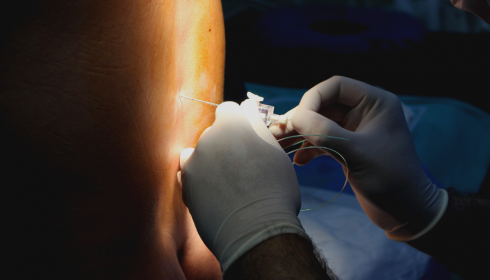BALANCE

Anaesthetic depth and complications after major surgery
Short. Lancet 2019; Published online 20 October 2019. doi:10.1016/S0140-6736(19)32315-3
Clinical Question
- In patients undergoing major surgery who are at high risk of complications, does light anaesthesia (BIS 50) compared with deep anaesthesia (BIS 35) improve survival at 1-year?
Background
- Anaesthesia (a state of controlled loss of consciousness) is induced by the administration of drugs, titrated to a depth justified by patient factors, surgical factors and anaesthetic factors
- It has been observed in large studies that there is an association between depth of anaesthesia, blood pressure and the incidence of mortality after surgery, but a causal link has not been established
- It is possible that patients that are at high risk of complications after surgery, including death, could benefit from the depth of their anaesthesia being titrated to a lighter plane
- Bispectral Index (BIS) is one available processed electroencephalographic monitor that attempts to quantify depth of anaesthesia on a scale from 0 to 100, with 0 being a state of no cortical brain activity and 100 being conscious
- It is recommended by the manufacturer of BIS to maintain depth of anaesthesia between 40 and 60.
Design
- Multi-centre, international, randomised, controlled trial
- Convenience sampling of applicable patients
- Randomised by secure web-based portal stratified in blocks of 8 by geographical region
- Patient and research assessor remained blinded to allocation
- Anaesthetist was made aware of group allocation but only after they had defined:
- Use of “major regional anaesthesia” as part of the anaesthetic
- Target range for mean arterial pressure (MAP)
- Intention-to-treat analysis for primary outcome, with per-protocol and worst-case-scenario sensitivity analyses also conducted
- Sample size calculation identified that 6500 patients were required
- Expected mortality: 10%
- Type 1 error (“false positive” or α significance): 5%
- This was adjusted to 0.049 to allow for an interim analysis
- Power (“false negative” or β error): 80%
- Inflation for anticipated loss to follow-up: 2%
- The primary outcome was assessed by the log-rank test stratified by geographical region and expressed as a time-based Hazard Ratio
- The trial was registered and the methodology was described in advance
- The funding body did not influence the conduct of the trial
Setting
- 73 centres from 7 countries (Australia, China, Ireland, New Zealand, the Netherlands and the UK)
- December 2012 to December 2017
Population
- Inclusion: aged over 60 years; ASA physical status 3 or 4; surgery with expected duration > 2 hours; anticipated hospital stay of at least 2 days
- Exclusion: inability to place electrodes across head due to nature of surgery; planned wake-up test during surgery; planned use of nitrous oxide or ketamine (at more than 25 mg/h); anticipated to be lost to follow up at 1 year
- 18026 patients screened –> 6644 patients recruited
- There were no significant differences between the groups (BIS 50 Light vs BIS 35 Deep)
- Age: 72 vs 72 years
- Sex: 64% vs 63% male
- ASA 3: 95% vs 95%
- Surgery for cancer: 46% vs 47%
- Intra-abdominal surgery: 46% vs 46%
- Vascular surgery: 29% vs 20%
- Planned post-op ICU: 14% vs 15%
Intervention
- BIS 50 Light
- Depth of anaesthesia was titrated to achieve BIS 50 ± 5 during the maintenance phase of anaesthesia
Control
- BIS 35 Deep
- Depth of anaesthesia was titrated to achieve BIS 35 ± 5 during the maintenance phase of anaesthesia
Management common to both groups
- The maintenance phase of anaesthesia was consider to be from 10 minutes after induction to cessation of volatile anaesthetic agent administration
- Maintenance was maintained by volatile anaesthetic agent
- TIVA, nitrous oxide and ketamine (above 25 mg/h) were not allowed
- BIS was not pursued to the extent that patient safety was compromised
- BIS was electronically recorded and averaged for each case
- Pre-defined individualised blood pressure (MAP) was targeted, electronically recorded and averaged for each case
- Minimum alveolar concentration (MAC) of volatile anaesthetic agent administered was electronically recorded and averaged for each case, and was not age-adjusted
Outcome
- Clinical data:
- A difference of BIS 8.4 was achieved between the groups
- BIS 50 Light: median BIS 47.2 [IQR 43.7–50.5]
- BIS 35 Deep: median BIS 38.8 [IQR 36.3–42.2]
- MAP was 3.5 mmHg (4%) higher in the BIS 50 Light group
- BIS 50 Light: median MAP 84.5 [IQR 78.0–91.3]
- BIS 35 Deep: median MAP 81.0 [IQR 75.4–87.6]
- MAC was 0.26 (30%) lower in the BIS 50 Light group
- BIS 50 Light: median MAC 0.62 [IQR 0.52–0.73]
- BIS 35 Deep: median MAC 0.88 [IQR 0.74–1.04]
- Major regional anaesthesia was not different between groups (17%)
- A difference of BIS 8.4 was achieved between the groups
- Primary outcome: There was no difference in mortality by 1 year between the groups
- BIS 50 Light: 6.5% died
- BIS 35 Deep: 7.2% died
- Absolute risk reduction (ARR): 0.76% (95% CI -0.45% to 1.97%; P = 0.22)
- Hazard Ratio (HR): 0.88 (95% CI 0.73 to 1.07)
- Secondary outcome: None of the secondary outcomes were statistically different (except one – neuropathic pain intensity – that was arguably not different to a clinically meaningful level)
- Myocardial infarction, cardiac arrest, pulmonary embolism, stroke or a composite of these
- Sepsis, surgical site infection or a composite of these
- Intensive care unit length of stay
- Awareness during anaesthesia
- There was one confirmed case in the BIS 50 Light group, giving an incidence of 3 per 10,000 cases (0.03%) when BIS is targeted to 50
- Disability score (WHODAS)
- Persistent pain
- Cancer recurrence
- Sensitivity analysis: The per-protocol analysis (38% were excluded due to mean BIS being out of target range, lost to follow-up or other major protocol violations) and worst-case-scenario (all lost to follow-up assumed to be dead) did not come to a different conclusion
Authors’ Conclusions
- No evidence was found that mortality or serious complication were modified by targeting either a BIS of 50 or 35
- A broad range of anaesthetic depth can be delivered safely when using volatile anaesthetic agents and processed electroencephalographic monitoring
Strengths
- Reasonable hypothesis based upon a clear theory drawn from observational data
- Appropriate study design to test the hypothesis
- Adequate concealment, randomisation method, blinding and allocation maintenance to minimise systematic biases
- Excellent data capture using digital recording, increasing the validity of the data and results
- Appropriate statistical analysis, using time-based rather than event-based analysis to improve statistical power and clinical meaningfulness
- On the assumption that BIS is equally valid (or not valid!) in all ethnic groups, this trial has excellent generalisability to all patients over 60 and of ASA 3 or 4 classification undergoing major surgery
Weaknesses
- The separation of BIS values between groups was not as large as had been intended, and therefore the lack of difference observed in the outcome may be in part due to the lack of separation
- Anaesthetists are perhaps uncomfortable delivering anaesthesia at the extremes of BIS 50 and 35
- The per-protocol analysis may have identified this, and whilst it failed to demonstrate any significant difference it will have been an underpowered analysis and a false negative conclusion may have been drawn
- MAC was not age adjusted, which is more significant in older patients such as those recruited in this trial
- The overall mortality rate was slightly lower than expected, which reduces the power of the statistical analysis and makes a false negative conclusion more likely
- Since only volatile anaesthetic agents were used, this trial cannot be extrapolated to TIVA or the co-administration of nitrous oxide
The Bottom Line
- This well designed and conducted trial demonstrates that there is probably no clinical benefit in targeting a lighter-plane of anaesthesia (BIS 50) compared to a deeper-plane of anaesthesia (BIS 35) in patients over 60 years of age at risk of complications after surgery (ASA 3 or 4)
- It does however demonstrate that a wide range of anaesthetic depth (BIS 35–50) and volatile administration (MAC 0.5–1.0) is safe in this population, and despite a median MAC of 0.62 the incidence of awareness remained acceptably low (approximating 3 in 10,000)
- Even though this has not shown a clinical benefit, given the financial cost and environmental impact of volatile anaesthetic agents, I think this trial shows it is possible to use BIS to guide delivery of a safe minimum dose
External Links
- [article] Anaesthetic depth and complications after major surgery: an international, randomised controlled trial
- [further reading] Depth of anaesthesia monitoring: what’s available, what’s validated and what’s next?
- [further reading] BIS from LITFL
Metadata
Summary author: Duncan Chambler
Summary date: 13 November 2019
Peer-review editor: Adrian Wong



